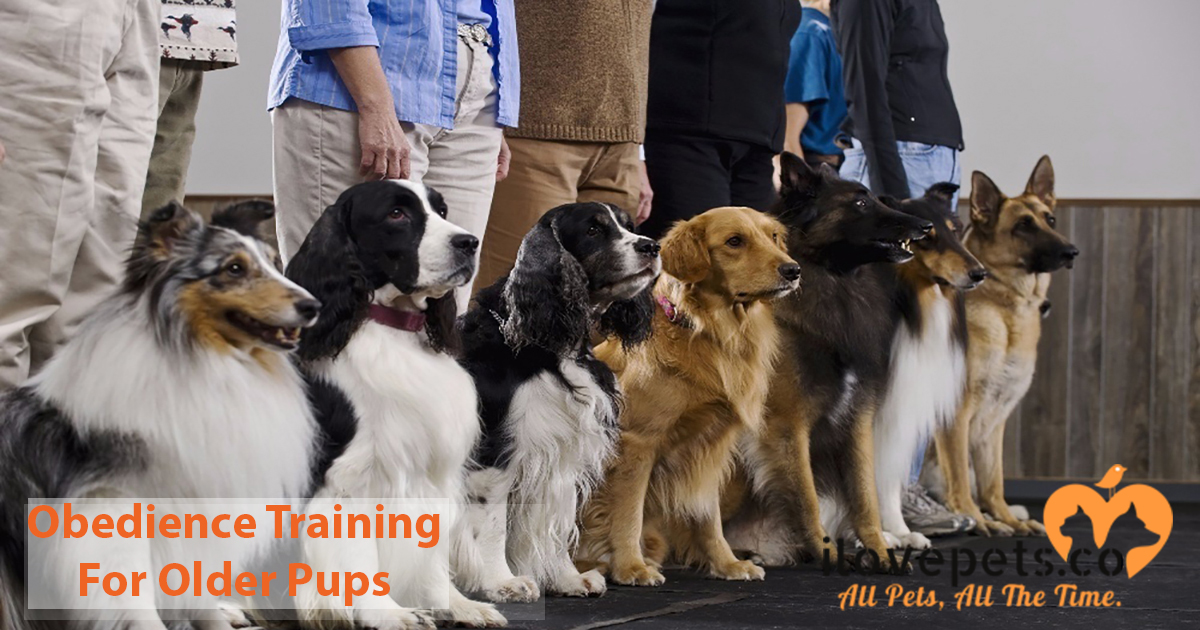
By the time he is six months old, a puppy has learned the rudiments of good behavior. He’s been housebroken for some time. He’s learned, let us hope, that it’s against the rules to jump up on beds, sofas, chairs or people. He responds – well most of the time – to such words as “no,” “come”, “down” and “quiet”. He knows what “good dog” and “bad dog” mean, and he’s a little bit of both.
Now, at somewhere between 6 and 9 months, it’s time for the puppy to progress into regular obedience training. Don’t skip this part of your pet’s education. It’s not difficult; a daily 10-minute session will work wonders.
Dogs like to be trained, and your work sessions will even further strengthen the bond between you. A well-trained dog is a source of great pride and joy. And most important of all, obedience training is essential to your dog’s own safety.
You can go as far as you want with this. Dogs can be trained to do almost anything. They will speak, beg, roll over and play dead for the doubtful amusement of your friends. They will serve as seeing eyes for the blind and hearing ears for the deaf. They will guard children, track down fugitives, and fight in wars.
But parlor tricks and working careers have little to do with regular obedience training. What is essential is that your dog learns to obey the following basic commands: sit, heel, stay and come. These are not for show. These are to keep him safe.
Going to School:
Obedience classes for canines are available in almost every community now. They range from self-governed clubs of pet owners who simply enjoy working together to highly professional schools that train dogs for show. Their prices range accordingly. In some areas, there are free obedience classes operated by the local ASPCA or humane society.

Professional obedience schools offer the advantage of training you to train your dog. The leaders will be as quick to spot your mistakes as puppy’s, and just as strict in correcting them. Also, dogs do learn from each other. In a highly disciplined class atmosphere, even a frisky puppy will follow the example set by other dogs – for a while, at least.
You must remember that young dogs have a short attention span. Most obedience classes will not accept a dog under six months of age and some not under one year.
If you have a purebred pup that you plan to enter in shows, then a professional school would be a good investment for you. If you have a problem pup, take him to a professional trainer; your dog will get expert and individual training. Or if you simply enjoy working with other pet owners, then, by all means, enroll in a class. Your veterinarian or local humane organization will refer you to training schools in your area.
Home Tutoring:
The basic obedience commands can also be taught at home, and there are strong arguments for home training. Whether you choose a class or the do-it-yourself method, you will have to work with the puppy, at home, every day. After all, obedience starts from home.

You want the puppy to “stay” in his own backyard, to “sit” in his own living room when guests arrive, to “come” when he decides to pursue a passing bicycle. So why not teach him on home grounds?
Anyone in the family can be the puppy’s trainer, but it should always be the same person. Training is a one-to-one thing; a dog learns as much from consistent voice inflections and body movements as from word commands. Children make fine trainers, but they must be willing to set aside at least 10 minutes every day to work patiently with their pet.
Rules of the Trainer:
And whoever does the job must first teach himself some simple rules of human etiquette in dealing with dogs. Your pup wants to learn; you’ll have no trouble if you follow these guidelines:
Reward and punishment are the bases for all training.
For a reward, praise and a loving caress are all that a dog asks. Experienced handlers advise against food tidbits; they’re apt to distract the puppy from his work. Your approval is what a puppy is working for so praise lavish, triumphant praise – is the magic ingredient of obedience training.

As for punishment, a sharp verbal reprimand is enough. Do not strike your puppy; it accomplishes nothing and may instill fear. If a sharper rebuke is called for, give a quick jerk on his collar or leash as you say “No!” Never harangue; get the correction over with quickly and move on. And always punish only at the moment of the crime; even a few seconds later he won’t know what you’re scolding him for.
Work for brief periods only. Puppies tire easily, and 10 to 15 minutes is as long as you can expect to hold his attention. Choose a time when he’s rested and relaxed, not after play or just before meals.
Be consistent in your commands, body movements, and voice inflections. Use the same words – simple, short words – to tell him what you want him to do. Repeat and repeat and repeat. Master one command completely before you move on to the next.
Tailor your teaching technique to match your dog’s disposition. The shy and timid pup needs a great deal of praise and encouragement. The aggressive, high-strung animal calls for a stricter hand.
End every training session on a success. This has great psychological importance. The puppy has worked hard, even if not always effective, and he needs your praise and approval.
Training Tools:
For equipment, you will need a leather leash, 6 to 7 feet long, with a strong bolt-type snap on one end and a loop on the other. (Don’t allow the puppy to chew on his leash and never strike him with it.)

You will also need a slip collar, which is a chain with a ring on each end. Hold one of the rings in your fingers and drop the chain through it; this forms a loose-fitting chin noose to slip over the puppy’s head. The slip collar is for training only. Never let the puppy wear it when he’s running free; it might get caught in something and choke him.
Always keep your dog on your left side during training. Hold the leash in your right hand, doubled up into a loop so that you have a short (but not tight) lead. The loop can be dropped to allow more slack in case puppy suddenly lunges forward. But the shorter lead is important for corrections.
When your pup makes a mistake, snap or jerk the leash. This is the puppy’s reminder that he is to do as you say, not what he wants. Make the snap correction, quick and sharp. Don’t drag it out; this is a signal, not a punishment.
Keep your body movements consistent; these convey as much to the dog as word commands.
Follow these rules:
- When you wish the dog to accompany you, always start with your left foot. Left foot first will become a recognized cue to walk.
- When you are going to leave the dog, start with your right foot. Right foot first becomes the signal to “stay.”
- When you stop, always stop on the right foot and bring the left foot into place.
Looking Ahead:
At the end of a year, he’s not a baby anymore. He’s still full of mischief on occasion, but he’s growing out of his adolescence and shaping up into a fine, well-behaved animal. He’s a much-loved member of the family now. At times he seems “almost human.”
But he’s not human. The dog has a remarkable ability to learn, but he can’t reason. Your pup’s behavior habits have been, and always will be, largely shaped and governed by you. It’s up to you to see that his behavior is such that he is a courteous and acceptable canine citizen, not only in your household but in your neighborhood and community.
Learn the leash laws of your area and obey them. They’re designed to make it possible for man and dog to live together in a crowded society. There must always be room for dogs. They give so much to all of us in devotion, loyalty, and companionship that the world would seem a lonely place without them.

The dog will do his part if we’ll do ours, so here are some reminders about your lifelong responsibility as a pet owner:
Don’t let your dog be a neighborhood bum
You may think he’s such an appealing and friendly little fellow that “everybody loves him.” Maybe, but not if the friendly little fellow soils your neighbors’ lawns, tramples their flower beds, topples their garbage cans, defecates on sidewalks, and gives every passing car and bicycle a merry chase.
Confining your dog is a matter of common courtesy to your neighbors. It is also the best way to keep him safe.
Don’t let your dog become a habitual barker or howler
Excessive barking can, indeed must, be trained out of him whenever the habit begins to develop. Don’t let your dog terrorize mailmen, meter readers, and other callers, even if you know he’s all bluff. “don’t worry, he won’t bite” is not always reassuring and not always true.
Don’t let your dog foul city sidewalks
This is one of the biggest problems in urban areas and one of the strongest arguments against big dogs as city pets.
Some cities in Europe and South America are even experimenting with outdoor toilets – confined areas covered with sand-for dogs. This could be a solution in the future. Meanwhile, the least you can do is exercise your pet on the leash only, and lead him directly to the curb when necessary.
Has your female dog been spayed?
Don’t let her have a litter unless you’re sure you can place every one of the pups in a good home. Pet overpopulation is becoming critical. There may be 80 million dogs and cats in the United States now, and it is estimated that at the present rate of increase this figure may reach 200 million within another decade. We are a nation of the animal lover. But there is a cruel and tragic side to our pet picture:
Nearly 13 million unwanted dogs and cats are destroyed annually at public and private shelters. Don’t take the chance of adding a single puppy to the population of helpless and homeless animals.
Give your dog good health care
You may think that’s taken for granted, but it shouldn’t be. Always remember that the dog has special needs and that he is dependent on you to keep him sound and healthy. He needs the specialized medical skills of the veterinarian for preventive immunization, for care when he’s ill or injured, for easing the aches and pains of advancing age. He needs a balanced, nutritious diet, specially formulated for dogs, not for humans, He needs to be kept clean and well-groomed; this too, is a part of good health.
Give your dog love and companionship
His happiness absolutely depends upon you. You are his whole world now. Show your affection often, play with him every day, take him on long walks regularly, pat him and praise him.
These are the things he counts on, to reassure him that he is loved. Let him be your best friend; he’s going to add much joy to your life in the years to come.
Good health and long life to you both!
About the Author: Tony Reed is a huge animal lover, currently having two dogs and three cats in his life. He is the content manager of a dog blog called Howpup where he writes about dog training, dog tips, and advice.






